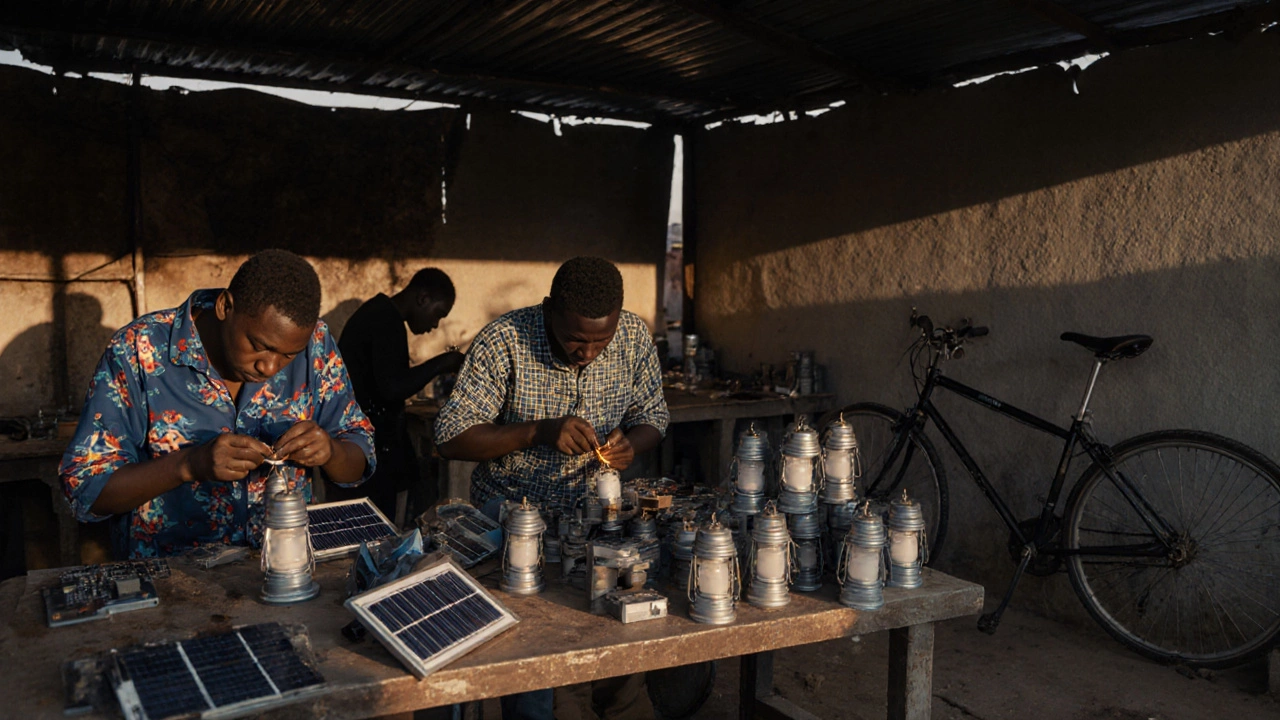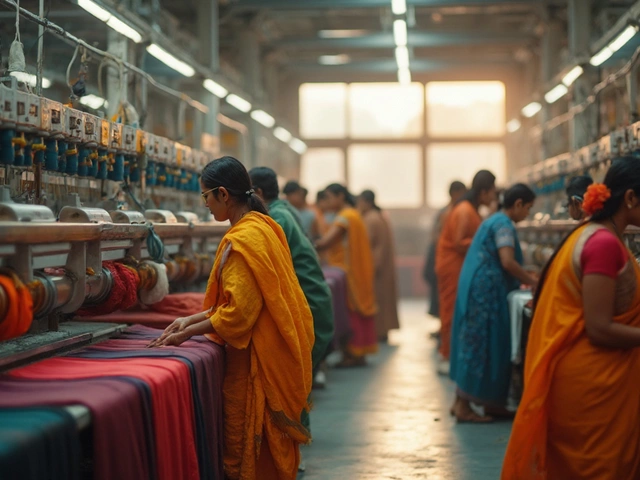Small Scale Manufacturing Profit Calculator
Calculate Your Potential Profit
Estimate your monthly and annual profit based on your small manufacturing business metrics.
Monthly Profit
$0.00
Profit Margin
0.00%
Annual Profit
$0.00
Note: Small scale manufacturers typically earn $30,000 to $150,000 annually with a few employees. Your results fall within this range for successful businesses.
Small scale manufacturing isn’t just about tiny factories or garage workshops. It’s a backbone of economies worldwide-especially in developing countries-where local entrepreneurs turn raw materials into everyday products with limited capital, fewer workers, and deep community ties. Unlike big factories that churn out millions of units, small scale manufacturing focuses on quality, flexibility, and serving niche markets. If you’ve ever bought handmade soap from a local vendor, a custom-made wooden toy, or freshly packaged spices from a neighborhood processor, you’ve already engaged with small scale manufacturing.
What exactly counts as small scale manufacturing?
There’s no single global definition, but most governments and economic agencies define it by three key limits: investment in machinery, number of employees, and annual output value. In India, for example, a small scale manufacturing unit can’t invest more than ₹10 crore (about $120,000) in plant and machinery. In the U.S., the Small Business Administration often classifies small manufacturers as those with fewer than 500 employees. In the EU, it’s typically under 250 employees and €50 million in annual turnover.
What makes it small isn’t just size-it’s how it operates. These businesses usually:
- Use manual or semi-automated equipment instead of full robotics
- Produce in batches of 10 to 1,000 units per run
- Source materials locally when possible
- Make products for regional markets, not global distribution
- Have owners who are hands-on in daily operations
Think of a family-run bakery that bakes 200 loaves a day using three ovens. Or a workshop in Nigeria that assembles solar-powered lanterns from imported parts. Or a workshop in Vietnam stitching 50 leather bags a week for local boutiques. These aren’t factories-they’re small scale manufacturing units.
How is it different from large scale manufacturing?
Large scale manufacturing is built for volume, efficiency, and standardization. Think car plants making 1,000 vehicles a day using assembly lines and AI-guided robots. Small scale manufacturing is built for adaptation. It doesn’t need to produce 10,000 units to break even. It can make 50 custom items and still profit.
Here’s how they compare:
| Feature | Small Scale Manufacturing | Large Scale Manufacturing |
|---|---|---|
| Investment | Under $120,000 (varies by country) | Millions to billions of dollars |
| Employees | 1 to 50 | 500+ |
| Production Volume | Low to moderate (batches) | High (continuous) |
| Automation | Manual or semi-automated | Highly automated |
| Market Reach | Local or regional | National or global |
| Product Customization | High-easy to modify designs | Low-standardized output |
| Startup Time | Weeks to months | Years |
The biggest difference? Risk. Large manufacturers bet big on one product line. If demand drops, they lose millions. Small manufacturers can pivot fast. If customers stop buying wooden toys, they can switch to making cutting boards-using the same tools, same space, same team.
What kinds of products are made through small scale manufacturing?
It’s not just about crafts. Small scale manufacturing covers a wide range of practical, everyday goods:
- Food processing: Jams, pickles, roasted coffee, bottled sauces, organic snacks
- Textiles: Handwoven fabrics, embroidered clothing, custom uniforms
- Plastics: Injection-molded containers, phone cases, garden tools
- Electronics: Simple circuit boards, LED lighting kits, repair parts
- Furniture: Wooden chairs, bamboo shelves, custom cabinets
- Pharmaceuticals: Herbal ointments, Ayurvedic supplements, local generic medicines
- Chemicals: Natural soaps, cleaning solutions, dye batches
Many of these products are made under local brand names you’ve never heard of-but they’re sold in neighborhood stores, farmers’ markets, and online shops. In Brazil, small manufacturers produce over 70% of the country’s footwear. In Bangladesh, 90% of garment exports come from units with fewer than 100 workers.

Why does small scale manufacturing matter?
It’s not just about making things. It’s about creating jobs, keeping money local, and preserving skills.
In rural India, a small textile unit might employ 12 women who’ve learned handloom weaving from their mothers. That’s not just income-it’s cultural preservation. In Kenya, a small metal workshop turns scrap into cooking pots, selling them to nearby villages. No corporate supply chain. No middlemen. Just direct trade.
Small scale manufacturing also drives innovation. Big companies avoid risky, low-volume products. But a small manufacturer can test a new design in a week. If it sells, they scale up. If it fails, they pivot. No board meetings. No shareholder pressure.
According to the International Labour Organization, small and medium enterprises (SMEs) account for over 90% of businesses worldwide and provide 50-60% of employment. Most of those are small scale manufacturers.
How do you start a small scale manufacturing business?
It’s simpler than you think-but it’s not easy. Here’s what actually works:
- Start with a real problem: What’s missing in your town? Are people buying imported spices at high prices? Are local schools needing durable lunchboxes? Solve a visible need.
- Use what you already have: Don’t buy a $20,000 machine on day one. Use a used mixer, a secondhand sewing machine, or a rented workshop space. Many successful units start in garages or backyards.
- Test before you invest: Make 20 units. Sell them to friends, at a market stall, or online. If they sell, you’ve got proof of demand.
- Apply for local support: Many governments offer grants, low-interest loans, or training for small manufacturers. In India, the MSME scheme provides subsidies. In the U.S., Small Business Development Centers offer free consulting.
- Focus on one product: Don’t try to make 10 things. Master one. Sell it well. Then expand.
One example: A woman in Colombia started making natural soap using coconut oil and local herbs. She began by selling 10 bars a week at the local market. Two years later, she’s exporting to three countries, employs eight people, and uses solar-powered drying racks. She didn’t need a factory. She needed persistence.

Challenges small scale manufacturers face
It’s not all success stories. Many small manufacturers struggle with:
- Access to finance: Banks often require collateral they don’t have.
- Raw material costs: Buying in small batches means higher per-unit prices.
- Power and infrastructure: Unreliable electricity or poor roads can shut down production.
- Competition from imports: Cheap mass-produced goods from China or other countries can undercut local prices.
- Lack of digital skills: Many don’t know how to use online marketplaces or social media to reach customers.
The smartest small manufacturers solve these by forming cooperatives-grouping together to buy materials in bulk, share equipment, or hire a single marketer for all of them.
What’s next for small scale manufacturing?
The future is local. As consumers demand transparency, sustainability, and unique products, small scale manufacturing is gaining ground. Platforms like Etsy, Amazon Handmade, and local e-commerce apps let small makers reach global buyers without big marketing budgets.
3D printing is also changing the game. A small workshop can now produce custom prosthetics, replacement parts for old machines, or even architectural models-without buying expensive molds.
And governments are waking up. Countries like Vietnam, Indonesia, and Ghana are offering tax breaks, training centers, and export assistance specifically for small manufacturers. The goal? Keep jobs at home and reduce reliance on imports.
Small scale manufacturing isn’t a stepping stone to becoming a big company. For many, it’s the end goal. It’s about building something real, something lasting, something that belongs to the community.
Is small scale manufacturing profitable?
Yes, if managed well. Profit margins are often higher than large manufacturers because there’s less overhead and more control over pricing. A small soap maker might sell a bar for $5 that costs $1.20 to make. That’s a 300% margin. The key is volume control and avoiding over-investment. Many small manufacturers earn $30,000 to $150,000 annually with just a few employees.
Do I need a degree to start small scale manufacturing?
No. Many successful small manufacturers learned by doing. What matters is understanding your product, knowing your customers, and managing money wisely. Basic math, record-keeping, and customer service skills are more valuable than a business degree. Free online courses from government agencies or NGOs can fill knowledge gaps.
Can small scale manufacturing compete with big brands?
Not by matching their prices-but by offering something they can’t: authenticity, customization, and local connection. People pay more for handmade, ethically made, or regionally unique products. A small brewery in Oregon sells out every week because customers know the owner and trust the process. Big brands can’t replicate that.
What’s the biggest mistake new small manufacturers make?
Buying too much equipment too soon. Many spend their savings on machines they don’t need. Start small. Rent space. Use secondhand tools. Test demand before scaling. The most successful units grow slowly, reinvest profits, and avoid debt.
Is small scale manufacturing eco-friendly?
Often, yes. Because they work in small batches, they waste less. Many use recycled materials, avoid plastic packaging, and source locally-cutting transport emissions. A small textile maker using organic cotton and natural dyes has a far smaller footprint than a factory churning out synthetic fabrics for global chains.





